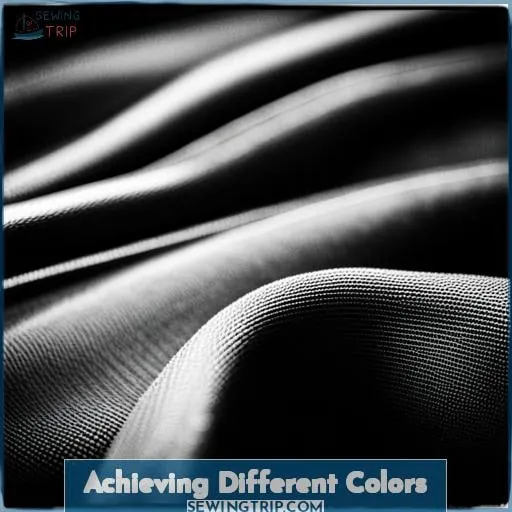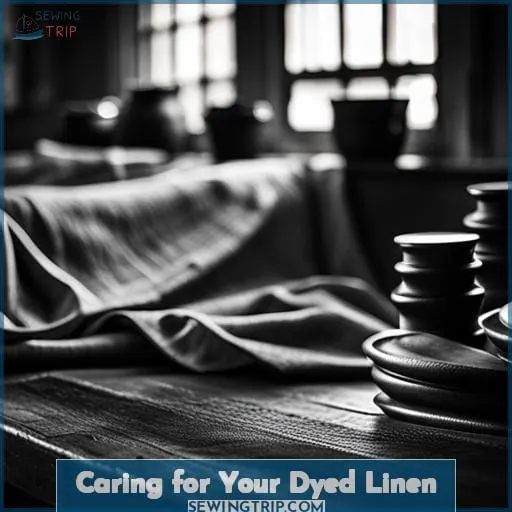This site is supported by our readers. We may earn a commission, at no cost to you, if you purchase through links.
 You’re ready for a creative adventure! Gather some tea and old linens as we head to the kitchen. The sweet smell of steeping tea fills the room as you gently lower the fabrics into the brewing bath—rich, black magic ready to transform those forgotten fabrics.
You’re ready for a creative adventure! Gather some tea and old linens as we head to the kitchen. The sweet smell of steeping tea fills the room as you gently lower the fabrics into the brewing bath—rich, black magic ready to transform those forgotten fabrics.
Now watch as they soak up that inky dye, ribbons of darkness diffusing through every fiber.
Feel the rough texture of natural linen become saturated with new life and purpose. Your homespun textiles are ready for their next incarnation—perhaps a cozy quilt or some bohemian apparel.
With simple ingredients from the pantry, you’ve rediscovered the joy of making and the warmth of handmade.
Table Of Contents
Key Takeaways
- Prepare natural dye materials such as black beans, tea, or black walnuts.
- Set up a dyeing station with supplies including a stainless steel pot, water, and detergent.
- Dye the linen in a simmering natural dye bath for one hour.
- Care for the dyed linen properly by washing it in fragrance-free detergent and avoiding direct sunlight.
Choosing Your Linen Fabric
When dyeing fabric, always determine the fiber content first. Linen and cotton take dye beautifully with natural plant-based dyes, but more preparation is required for silks and wools. The fabric type is key for choosing the proper dye materials and techniques. Natural fibers such as linen, cotton, silk, and wool each have their own distinct properties and will interact with natural dyes in unique ways.
Carefully consider the fiber content upfront before gathering materials and starting the dye bath.
Determine Fabric Type First
You’ll want to ensure your fabric napkins contain a high percentage of linen or are 100% linen before proceeding with natural dyeing. Natural dyes work best on natural fibers like linen, so a fabric burn test can help determine the exact fiber content.
Look for charring, melting, odor – 100% linen will burn quickly with an ashy odor. Blends may melt or self-extinguish. Once you’ve confirmed a high linen percentage, you’re ready to gather your materials and embark on an exciting dyeing process with beautiful color variety.
– Consider Fabric Weight
When selecting linen for dyeing, pay close attention to the fabric weight. Lighter weight linens absorb dye faster, resulting in darker colors. Heavier linens take longer to saturate, yielding paler hues. Consider your desired color vibrancy when choosing fabric weights.
Thinner linens work well for rich jewel tones. Sturdier weights suit lighter tea staining. Test samples first to ensure your linen type complements the natural dyeing technique.
– Select Natural Shade
After carefully picking your perfect linen weight, choosing a natural shade that allows the hues to soak in optimally helps get that ideal black as smooth as molasses. Look for organic shades with more texture that won’t interfere with the black. Experiment with fibers in their natural state to see how the pigments take before dyeing.
Gather Your Dyeing Supplies
Set up your dye station with the stainless stock pot, distilled water, and pH-neutral detergent nearby. You’ll need plenty of workspace to spread out the linen and buckets for soaking and rinsing. Gather natural dye materials like black beans, black tea, acorns, and black walnuts.
Stack the linen in your stainless pot and cover with distilled water. Slowly add the black dye materials and stir well to distribute evenly. Brew the dyebath approximately 1 hour, checking and stirring occasionally. Use protective gloves when handling dyes.
Follow safe practices for heating, lifting, and pouring. With these creative yet careful techniques, you’ll achieve beautiful, eco-friendly black linen through natural tea dyeing and more.
Make the Dye Bath
Place the crucible over the eternal hearth and nurture the prima materia within. Gather your preferred dyeing vessels, such as stainless steel pots, and fill with filtered water. Bring the water to a simmer, then add your chosen natural dyes, like black tea. The tannins in black tea will impart a range of deep brown to black hues on your linen.
Monitor the temperature carefully, keeping the dye bath just below a boil to protect the fiber integrity.
Test swatches first to fine tune your heating technique and achieve your ideal saturated black. Consider your time in the dye bath a contemplative ritual of patience and discovery.
Soon your linen will emerge transformed, infused with darkness from nature’s pigments.
Prepare and Scour the Fabric
To properly absorb the natural black dye, wash your fabric beforehand in unscented laundry detergent. This removes any debris, dirt, or finishes that may hinder dye absorption. Use the fragrance-free, hypoallergenic formula to prevent skin irritation when handling the scoured fabric.
For optimal results, wash in hot water and rinse until the water runs clear. Avoid using fabric softeners or dryer sheets as they leave a coating that blocks dye.
Proper scouring allows the natural dyes to bond directly with the fibers for rich, long-lasting color. With this eco-friendly preparation, your linen will be ready to become a vibrant masterpiece using sustainable practices.
Whether you’re a beginner or seasoned artisan, taking the time to correctly pre-wash your material makes all the difference in creating beautiful hand-dyed textiles.
Dye the Fabric
Hear your soul sing as the linen soaks up earth’s inky elixir. Transform your hand-woven linen napkins into shadows that delight.
- Select the dark coffee grounds or black walnut husks. Grind into a fine powder.
- Simmer the dye bath with water just under a boil. Add a splash of vinegar.
- Immerse the damp linen fully. Stir gently. Tend the fire.
- When satisfied with the intensity, remove and rinse well.
- Soak in salt water fixative. This seals the color against fading.
- Hang in the sunshine. Watch the linen dry into midnight hues.
Revel in the imperfect variations that nature provides. Each napkin tells its own story based on where it lay in the brewing bath. Experiment more with twisted bundles or bold patterns. Just dip your toe first before diving full in.
Rinse and Wash the Fabric
You’ll wanna rinse that linen thoroughly in cold water before washing it with the fragrance-free detergent. Multiple cold water rinses will help remove excess dye and prevent bleeding, securing the color onto the fibers.
Agitate and squeeze the fabric gently to fully rinse. Eco-friendly techniques like using biodegradable, non-toxic soaps help preserve our planet while caring for your fabric. Proper rinsing and pH-neutral detergents lock in dye color for longer-lasting results.
Experiment with different mordants like vinegar or salt to see their effect. Refer to helpful natural dye books and online resources for a deeper color guide.
Share your creations with others interested in natural dyes to inspire and support new textile artists. Proper technique and fabric care help hand-dyed linens retain their color and uniqueness.
Optional – Use a Fixative
Round out your natural dyeing process by soaking the napkins in a saltwater fixative – it’ll help the color set and reduce bleeding. A fixative is a crucial extra step for lasting color vibrancy and minimal bleeding with natural dyes.
Simply soak the freshly dyed napkins in a bath of salt water. Use about 1/4 to 1/2 cup of salt per gallon of warm water.
The salt helps drive the dye into the fibers for better retention. Without this fixative step, natural dyes may continue to bleed excessively with washing. For best results, soak in the saltwater, rinse, then wash with a mild detergent before drying.
If you prefer to avoid salt, try vinegar or alum as alternative fixatives. Following through with this fixative treatment will maximize your natural dyeing success.
Drying and Finishing
Once dry, fold and iron your newly dyed napkins to impart a final touch of care. Proper drying and finishing will help the natural dyes set and the linen fibers relax. Opt for air drying in a shaded spot to avoid sun damage. Iron using a cool setting and avoid fabric softeners to prevent bleeding.
Smart storage solutions like cloth napkin rings or foldable pegs will minimize wrinkling between uses.
Treating your hand-dyed linen with care will enhance longevity. As you serve meals with your earth-toned napkins, reflect on the mindfulness of natural dyeing and how small acts of creativity support our innate need for purpose.
Achieving Different Colors
Trust me, determining the right cotton craft white dinner napkins, Imusa stainless stock pot, and Heritage Park fragrance-free laundry detergent helps you effortlessly achieve different colors when dying linen black and white naturally.
With the right materials and a spirit of experimentation, you can create an array of muted tones and deep hues using natural dyes.
Approach dyeing as an artistic process – have fun, get messy, and see what emerges.
| Dye Source | Possible Colors | Mordant Needed? |
|---|---|---|
| Turmeric | Yellow | No |
| Beetroot | Pink, red | No |
| Blueberries | Lavender, blue | Yes |
| Onion skins | Orange, brown, yellow | No |
| Black beans | Grey, charcoal | No |
Keep an open mind and let the fabrics guide you. Record your experiments to recreate favorites. Share extra dyestuff with fellow artists and be mindful of sustainability. Most of all, enjoy immersing yourself in the age-old craft of natural dyeing.
Caring for Your Dyed Linen
You’ll need to gingerly wash your treasured black linen napkins in a gentle, fragrance-free detergent to preserve their color and integrity. Hand washing is ideal, using a few drops of pH-neutral soap in cool water. Agitate gently, never wringing or twisting the damp cloth.
Simply press water out before reshaping and laying flat to dry. For machine washing, turn linens inside out and use the delicate cycle with cold water. Skip the fabric softener, as it can diminish natural fibers over time. Always air dry instead of machine drying to prevent heat damage.
Store out of sunlight in a breathable fabric bag or basket to prevent fading. With some care, those ebony napkins will retain their rich, inky black tones for ages, naturally accenting fine meals without chemicals or cost to our earth.
Rest assured, a touch of elbow grease removes stains if they arise. Pair diligence with compassion when preserving your hand-dyed textiles.
Conclusion
You’ve now embarked on the creative journey of using food scraps to naturally dye linen, contributing to reducing waste and making something beautiful for yourself, loved ones, or your home. Though it requires some trial and error, you join generations of artists who found joy and purpose in sustainable textile traditions.
Trust the process, learn from each dye bath, and let your linen creations blossom into something deeply personal.
















